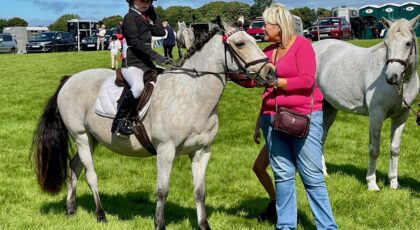Although it doesn’t quite feel like it, fall is finally here again (in the northern hemisphere, anyway).
The leaves will soon change, and the daylight hours will continue to decrease. We may not have as much time to spend with our horses in the coming months, but it’s important to prepare for dropping temperatures before they arrive.
Horses are naturally well-equipped to deal with cold weather, but they can still benefit from a little help on our part.
Here are ten tips for keeping your horse healthy through fall and winter:
1. Monitor grass intake

©Casie Bazay
Keep a close eye on grass intake, especially in the fall, for horses with insulin resistance, equine metabolic syndrome, or who are prone to laminitis. Near or below freezing temperatures stress the grass, causing a rise in non-structural carbohydrates (NSCs). Brown grass isn’t necessarily better, either. At-risk horses may need a grazing muzzle or to be kept off pasture, even during colder weather.
2. Have older or thin horses’ teeth checked and floated, if necessary

©Casie Bazay
Fall is a good time to do dental care since horses naturally have more trouble maintaining their weight in cold weather. Hopefully, this will allow them to better chew and utilize their feed and hay during the fall and winter months.
3. Invest in heated water buckets or a stock tank heater

©Casie Bazay
Horses often drink less in cold weather, which can lead to the dreaded condition of impaction colic. To keep your horse drinking, offer fresh water that isn’t freezing cold. Between 45-65 degrees Fahrenheit is ideal.
4. Supplement loose salt

©Casie Bazay
Horses need salt year round. (There’s never enough in hay or grass.) Adding it either by free choice or in your horse’s feed ration in the fall and winter has the added benefit of encouraging them to drink more water.
5. Feed a good prebiotic or probiotic

This is especially important for older horses or any horse transitioning from grass to hay. Probiotics help populate the gut with beneficial bacteria and aid the digestive process. Prebiotics, however, are food for these good bacteria. Either one can help with feed transitions.
6. Don’t blanket healthy horses

©Casie Bazay
I know blankets are the in thing, but a horse with a good winter coat will be just as warm, if not warmer. Horses’ coats will “fluff up” and insulate them quite well if we don’t interfere. So unless a horse is ill, severely underweight, or just doesn’t grow a good winter coat, blankets aren’t necessary.
7. As temperatures decrease, increase the amount of forage fed

©Casie Bazay
Many people increase the amount of concentrates they feed to their horse in winter, but it’s forage that is better utilized by the horse. Forage contains a much higher fiber content than grains and when this fiber is digested (through bacterial fermentation), heat is produced in the horse’s body. Horses will stay warmer if they have forage provided on a near continual basis (slow feeders are great for this). A good rule of thumb to follow: For every 10 degrees Fahrenheit it is below freezing (32 degrees F), increase your horse’s hay ration by 10 percent.
8. Provide shelter of some kind

©Casie Bazay
Horses don’t necessarily need to be stalled in cold weather, but they do need access to shelter from the wind and rain. A barn, lean-to, or even a thick grove of trees will do the trick.
9. Maintain regular hoof care

Just because you may not be riding your horse as much when it’s cold doesn’t mean you should neglect his hoof care. Horses’ feet still grow in the fall and winter (although many say at a slower rate) and will need regular maintenance. Additionally, barefoot horses tend to have better traction on ice and snow, so it’s wise to pull your horse’s shoes in the winter (if they aren’t already barefoot).
10. Pay extra attention to older horses in cold weather

©Summer Nicholson
Older horses often need more calories to maintain their weight since they tend to have more trouble digesting hay. Their fluffy coats may also hide the fact that they’ve lost weight. Hay substitutes such as hay cubes (best soaked) or beet pulp (also should be soaked) are great to add to their diets. Some horses may require a senior feed as well.
About the Author
Casie Bazay is a freelance and young adult writer, as well as an owner/barefoot trimmer and certified equine acupressure practitioner. She hosts the blog, The Naturally Healthy Horse, where she regularly shares information on barefoot, equine nutrition, and holistic horse health. Once an avid barrel racer, Casie now enjoys just giving back to the horses who have given her so much. Follow Casie at www.casiebazay.com.




 October 11, 2017
October 11, 2017 




























